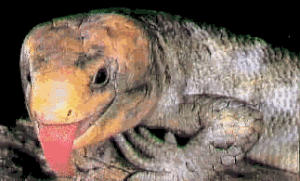 Prehensile SkinkThe Prehensile-tailed Skink (a.k.a. Monkey-tailed Skink, Solomon Island Skink, and Zebra Skink) is one of the larger skink species. In the wild, C. zebrata are found inhabiting the Solomon Islands and Papua New Guinea of the South Pacific. Crepuscular and nocturnal in nature (active around the dusk to dawn hours), C. zebrata can be found primarily in the trees and on occasion foraging on the ground. During the day these lizards will hide or nest in tree hollows or branches of dense old-growth trees. C. zebrata is primarily an herbivore, which is unusual among skink species. Wild specimens have been noted to reach lengths of 30 to 32 inches, of which the tail comprises 14 to 18 inches. Captive specimens generally are smaller in size.
Prehensile SkinkThe Prehensile-tailed Skink (a.k.a. Monkey-tailed Skink, Solomon Island Skink, and Zebra Skink) is one of the larger skink species. In the wild, C. zebrata are found inhabiting the Solomon Islands and Papua New Guinea of the South Pacific. Crepuscular and nocturnal in nature (active around the dusk to dawn hours), C. zebrata can be found primarily in the trees and on occasion foraging on the ground. During the day these lizards will hide or nest in tree hollows or branches of dense old-growth trees. C. zebrata is primarily an herbivore, which is unusual among skink species. Wild specimens have been noted to reach lengths of 30 to 32 inches, of which the tail comprises 14 to 18 inches. Captive specimens generally are smaller in size.
Captive Environment
Due to their arboreal nature, a C. zebrata enclosure should be at least four-feet long x two-feet wide x four-feet in height. For enclosures with more than one specimen, the dimensions should be increased. Enclosures of these proportions are not readily available on the pet supply market and may require home construction or a custom cage order. Certainly, a large aquarium may be used for the short-term for small specimens, but these cages are horizontally oriented and are wholly inappropriate for larger specimens. Enclosures should be constructed to allow daytime temperatures of 82 to 90° F and nighttime temperatures in the mid-70° s, while maintaining a humidity of about 70%. An enclosure should retain humidity, while at the same time providing adequate ventilation. Cage lighting should include a full-spectrum fluorescent bulb (Vitalite or Reptisun), a basking light, and (if necessary to maintain nighttime temperatures) a “nightbulb” or ceramic heater. Because C. zebrata habitat is equatorial, “daylight” should be provided for 12 hours per day throughout the year. Humid air may be produced by daily misting– automatic or with a spray bottle– or humidifying devices. Water should be available at all times, which may also help maintain humidity. In the wild, C. zebrata experience a wet season from November to April. This wet season may be reproduced by daily enclosure saturation during those months. This may be a signal for the start of mating season. Due to their largely herbivorous diet, C. zebrata defecate frequently and voluminously. Consequently, cage substrate should be of a type that is easy to clean routinely—newspaper or plastic (outdoor) carpeting. Cages should also be equipped with adequate branches for climbing and aboveground hide boxes—hollow logs, wooden boxes, large PVC piping. Enclosures may be stocked with live plants, which may be aesthetically pleasing and help maintain enclosure humidity. But, due to the herbivorous nature of C. zebrata it is reasonable to expect any plants placed in an enclosure to be eventually sampled and/or consumed. It is essential to use only non-toxic plant species. It is unreasonable to expect animals to distinguish between toxic and non-toxic plants and make the safe decision. Pothos plant species are a safe choice for use in captive environments.
Diet
The diet of C. zebrata may include, but is not limited to, the following: endive, escarole, kale, apple, carrot, banana, hard-boiled egg (with the shell and chopped), pear, kiwi, papaya, plums, mango, collared greens, turnip tops, spinach, yellow squash, sweet potato, mustard greens, Pothos leaf, etc. The diet should probably consist of no more than 20% fruit. Neonates may be fed jarred baby foods and greens chopped to an appropriate size. Young animals should be fed on a daily basis, while adult specimens may be fed on a every-other-day basis. Foods may be dusted with a vitamin supplement (Nekton-REP) to help alleviate nutritional deficiencies that often arise from a captive diet.
Michael S. Samuels, D.V.M.
Central Animal Hospital